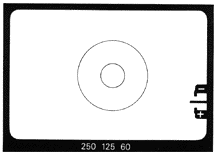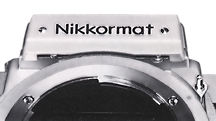 |
1. Viewfinder and Focusing Screen |
The Nikkormat FTN finder
provides center-weighted through-the-lens exposure metering that is coupled to the
shutter speed and lens diaphragm. The meter reads light over the entire picture area
in the viewfinder, but favors the central 12mm-diameter reference circle. Making
use of the automatic diaphragm of the Nikkor Auto lenses, the exposure meter measures
light at the maximum aperture of the lens in use. The needle appears on the right
side of the picture field, between the plus and minus marks which indicate over-
and under-exposures respectively. The preset shutter speed is given in white, below
the viewed subject, between two values (in yellow) that represent the "neighboring"
shutter speeds. The needle also appears atop the camera body. The metering range
extends from EV3 to EV17 at ASA100, the aperture coupling range from f/1.2 to f/32.
The ASA film speed scale is provided on the shutter speed ring to set the film speed
into the exposure meter. The scale is numbered from ASA 12 to 1600, with two dots
between the numbers indicating intermediate values such as 32, 64, 80, etc. The setting
is done by sliding the slotted ASA index pointer to line it up with the ASA number
of the film in use.
 |
Through-the-lehs exposure metering at full aperture requires setting the maximum aperture of a lens in use into the meter. After mounting the lens, just turn the aperture ring all the way to the minimum f-stop setting, then to the opposite direction as far as it will go. The maximum aperture thus set can be confirmed with the scale provided on a ring next to the shutter speed ring. |
The scale ranges from
f/1.2 to f/5.6, with the f-numbers 1.2, 2.8 and 5.6 marked on the ring. The exposure
meter is powered by a 1.3V mercury battery (These Mercury Cells are not enviromental
friendly, but Zinc Oxide subsitute may works) embedded in the battery chamber on
the camera baseplate. The meter is turned "on" or "off" by means
of the film advance lever.
The diaphragm of a any AI or AIS lenses or older Nikkor Auto lens is kept fully open
except when the shutter is released. This gives the brightest possible and the most
shallow image on the focusing screen for easy and accurate viewing/focusing. The
Nikkormat FTN camera is equipped with a focusing screen which consists of a matte/Fresnel
with a central 4mm-diameter microprism spot *.
 |
* Those days, the FTn also came with an specify order of optional screen that consists of a matte/Fresnel field with a central split image rangefinder spot, but it is non-interchangeable by users as the case of FM/FE later (We will feature both cameras under the Modern Classic SLR series). |
The Nikkormat FTn camera shares many of the system accessories with the professional
Nikon F & F2. For Macro works, flash syetem (Check BC-7 flash section), and many miscellaneous accessories that available within the Nikon
system.
| Next | Part II covers : Film Advance Lever | Frame Counter | Film Rewind Crank | Film Plane Indicator | Shutter Speed Ring | Shutter Release Button
Part III covers : Shutter | Self-Timer | Flash Synchronization | Reflex Mirror/Mirror Lock Up | Depth-of-Field Preview Button | Lens-Lock Release Button | Lens Mount Flange | Camera Back | Tripod Socket
| Back to Nikkormat FTn
Index Page |
| Back |
to Main Index
Page of Nikkormats
| Message Board | for your favourite Nikkormats
| Message Board |
for your Nikon Optics in a shared environment
| Message Board |
Specifically for Dispose or Looking for Nikon/Nikkor Photographic
Equipment
History
& Background
of Nikkormat Cameras
| "Nikomat" Picture Library
of Japanese local version | Outline
the
major
key features and differences
of various models
The
Camera Bodies
| FT | FS | FTn | EL | FT2 | ELW | FT3 | EL2
This
site is made out 15.5MB with 478 items
(Jpeg, Gif, PDF & HTML files) (Last Update: 25th May 1999)
| Main Reference
Map
|
HTML Format: FT | FS | FTn | EL | FT2 | ELW | FT3 | EL2 | AW-1 Motor Winder
PDF Format: FT
| FS | FTn | EL | FT2 | ELW | FT3 | EL2 | AW-1 Motor Winder
| Specifications |
FT
| FS | FTn | EL | FT2 | ELW | FT3 | EL2
 |
The Eyes of Nikon:- |
Fisheye-Nikkor Lenses - Circular | Full Frame | Ultrawides Lenses - 13mm15mm18mm20mm | Wideangle Lenses - 24mm28mm35mm |
Standard Lenses - 45mm 50mm 58mm | Telephoto Lenses - 85mm105mm135mm180mm & 200mm |
Super-Telephoto Lenses - 300mm 400mm 500mm 600mm 800mm 1200mm |
Special Application lenses:
Micro-Nikkor Lenses - 50mm~55mm -60mm 85mm -105mm 200mm Micro-Zoom 70-180mm
Perspective Control (PC) - 28mm 35mm PC-Micro 85mm
Dedicated Lenses for Nikon F3AF: AF 80mm f/2.8 | AF 200mm f/3.5 EDIF
Depth of Field Control (DC): 105mm 135mm
Medical Nikkor: 120mm 200mm
Reflex-Nikkor Lenses - 500mm 1000mm 2000mm
Others: Noct Nikkor | OP-Nikkor | UV Nikkor 55mm 105mm | Focusing Units | Bellows-Nikkor 105mm 135mm
Nikon Series E Lenses: 28mm35mm50mm100mm135mm | E-Series Zoom lenses: 36~72mm75~150mm70~210mm
MF Zoom-Nikkor Lenses: 25~50mm | 28~45mm | 28~50mm | 28~85mm | 35~70mm | 36~72mm E | 35~85mm | 35~105mm | 35~135mm |
35~200mm | 43~86mm | 50~135mm | 50~300mm | 70~210mm E | 75~150mm E | 80~200mm | 85~250mm |
100~300mm | 180~600mm | 200~400mm | 200~600mm | 360~1200mm | 1200~1700mm
Tele-Converters: TC-1 | TC-2 | TC-200 | TC-201 | TC-300 | TC-301 | TC-14 | TC-14A | TC-14B | TC-14C | TC-14E | TC-16 | TC-16A | TC-20E
![]()
Nikon F
| Nikon F2 |
Nikon
F3
| Nikon F4 |
Nikon
F5
| Nikon F6 |
Nikkormat / Nikomat |
Nikon FM
| Nikon FE/ FA | Nikon EM/FG/FG20 | Nikon Digital SLRs | Nikon - Other models
MIR Supports for Photographic Community: Various Message Boards/Community
Forums
Nikon
F-series|
Nikon
F2-series|
Nikon
F3-series|
Nikon F4-series| Nikon
F5-series|Nikkormat/Nikomat-series
Nikon FM-series|Nikon
FE-series|Nikon
FA|Nikon
Digital
SLR
series|Various
Nikon
Models|Nikkor
Optic
-shared
Others:- Free Trade Zone - Photography| Free Trade Zone - Business Community |Free To Zouk - Photographic Community
Apple's Mac Public Community Message Board | Windows based PC &
Apple/Mac
Public Community Trade Exchange Centre
Recommended links to understand
more technical details related to the Nikkor F-mount and production Serial Number:
http://rick_oleson.tripod.com/index-153.html by: my friend, Rick Oleson
http://www.zi.ku.dk/personal/lhhansen/photo/fmount.htm by: Hansen, Lars Holst
http://www.mir.com.my/rb/photography/hardwares/nikonfmount/lens2.htm
http://www.photosynthesis.co.nz/nikon/serialno.html
About
this photographic
site.
Home - Photography
In Malaysia
![]()
Copyright
© 1998.
HIURA Shinsaku ® ; Nikomat ML, Japan,
in collaboration with leofoo ®. MIR Web Development Team.
* Credit: A
Great thanks to Mr Denis Pleic for his volunteering
effort to reedit content and and patching some grammatical mistakes found in this
section of the PIM site. Miss
Rissa (Marketing) & Edward
(Techical) of Shriro Malaysia, distributor of Nikon cameras in Malaysia, in providing
so many useful inputs to make this site possible. Mr Hong,
Ipoh for lending me his FT2 to take some of the images used in this site. This site
is created for his eldest son, Yuen who has picked up his father's hobby and
the FT-2. My friend, John Walls from Florida, US for his images of the FTn
body and the Zoom Nikkor
43-86mm.
[Left Brain][Right brain][Home-MIR] [Invention][Art & Design][Clubs]
[Portfolios][On assignments] [Trading room][Knowledge & Resources] [Free-trade-zone][Thoughts & opinions][Links]